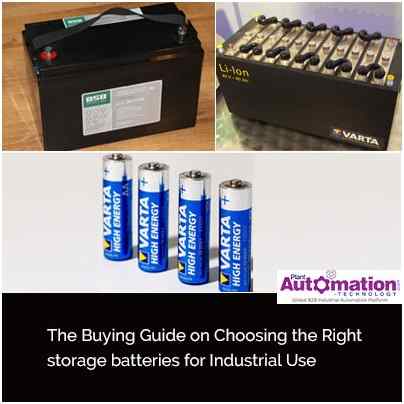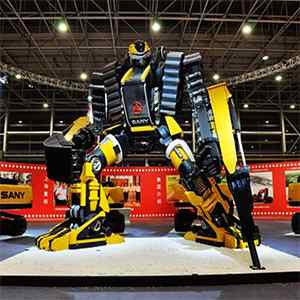The Buying Guide on Choosing the Right Storage Batteries for Industrial Use

Unlike primary cells, the industrial storage batteries can be supplied with direct current (DC) of the correct polarity and recharged to or near their original energy content and power capability i.e. they can repeatedly store electrical energy. They are electrochemical devices that convert higher-level active materials into an alternate state during discharge. The battery materials are chemical and the metals most widely used to manufacture primary and secondary batteries. These materials depend on properties such as crystal size and shape, doping, porosity, surface modification, and crystallinity. Depending on these properties, the battery performance is measured based on power density, energy density, stability or cyclability, safety, and price. The rapid industrialization, rising demand for high capacity power storages, and increasing expenditure on research activities are some of the prominent market factors and trends identified in the industrial storage batteries market. Moreover, due to the surging electrification industry, the demand for industrial storage batteries is expected to witness significant growth over the assessment period. During the review period, the rising uninterrupted electric energy demands across the globe are estimated to be an important driver of the industrial batteries market. The industrial storage batteries are widely used in the industries to incorporate the automation of handling and construction machinery, small transport vehicles, and robotics which requires batteries. However, the usage of toxic organic chemicals used in the production of industrial storage batteries has been restricted by the implementation of strict regulations by various government bodies, which is predicted to hinder the growth of the market.
Types of Industrial Storage Batteries
A) Lead-Acid Batteries
B) Lithium Storage Batteries
C) Alkaline Storage Batteries
Storage Battery buyers guide
Why Choose a Lead Acid Battery

Also known as lead storage batteries, they can store a lot of charges and provide high current for short periods. The lead-acid battery is capable of being recharged, which is important for their use in cars. For products that consume more power like projectors, large sound systems, and motorized projects you should use lead-acid batteries. They are heavy to ship, reliable and contain toxic materials that need specific removal methods at the end of their useful life. Lead-acid battery has moderate power density and good response time. The lead-acid battery is affected by temperature and must be maintained to achieve maximum life expectancy. A few things to consider when choosing a lead-acid battery are –
- Life span and cost - If you need a short-term solution then think about the cheaper, lead acid alternative.
- Maintenance and disposal - The lead-acid batteries require considerable maintenance. The users need to ensure the batteries are sufficiently filled with water to avoid costly structural damage and reduce fire risk. Choose lead acid if you’re able to check and adjust water levels and want to reduce costs. And as the name implies, lead acid batteries are filled with corrosive compounds that harm the environment when handled improperly.
- Performance – The performance of the lead-acid batteries suffers as charge decreases.
- Safety – The lead-acid battery includes sophisticated safeguards and carries a higher fire and explosion risk.
- Charging – Given the rate of charge, maintenance requirements or other factors, some systems such as solar panel installations favor lead-acid or lithium batteries. Review the specifications of your application carefully and try to determine if lithium or lead-acid provides better storage.
Why Choose a Lithium-Ion Battery?

Commonly used for electronic vehicles and portable electronics, a lithium-ion battery or Li-ion battery is a type of rechargeable battery. It’s growing in popularity for aerospace and military applications. The lithium-ion batteries are designed to be recharged hundreds of times. The high power density offered by lithium-ion batteries is a distinct advantage. Besides, they can deliver up to 3.6 Volts, 3 times higher than technologies such as Ni-Cd or Ni-MH. Much of the promise of Li-ion technology, from a clean energy perspective, comes from their potential applications in battery-powered cars. Initially, they can be more expensive to purchase, but this is changing rapidly as the push for fewer cost batteries for electric vehicles as well as domestic energy storage systems has spurred on several manufacturers to decrease prices and increase availability. A few things to consider when choosing a lithium-ion battery are –
- Life span and cost – The lithium batteries generally perform better than lead- acid in the long term and need fewer replacements, but require a higher upfront cost. Moreover, if you need to power an application over many years and don’t want the performance to suffer, lithium is the way to go.
- Maintenance and disposal - Typically, the lithium batteries require no maintenance, as they don’t need water to operate. If you’re unable or unwilling to check in on your system routinely, lithium is the solution. Choose lithium if you’re environmentally conscious and want to minimize your battery’s footprint after disposal.
- Performance – Although the lithium and lead-acid batteries are both suitable for different capacity needs, the lithium loses less power to natural discharge, improving efficiency. The performance is maintained until near the point of exhaustion. Hence, lithium batteries excel at expending energy until close to empty and then recharging it to full (i.e. deep cycling).
- Safety – When chemical instability or overloading occurs, most rechargeable lithium-ion batteries are designed to rupture and release energy mitigating risk.
- Charging – Review the specifications of your application carefully and try to determine if lithium or lead-acid provides better storage. The bottom line is that lithium batteries generally provide better long-term benefits.
Why Choose an Alkaline Battery

The alkaline batteries are disposable batteries with zinc and manganese dioxide as electrodes. Either potassium of sodium hydroxide is used as the alkaline electrolyte. Compared to the carbon-zinc batteries, these batteries have a stable voltage offering better energy density and leakage resistance. The alkaline batteries can be recharged. However, it’s not considered to be cost-effective and does have some risks. Recharging battery can cause gas production within the battery. Since an alkaline battery is normally sealed; very high pressures can be created within it. As alkaline batteries provide more energy than zinc batteries, you can use the alkaline cells for appliances such as toys and game controllers, toothbrushes, etc.
| Also Read: Empowering Automation: The Role of Storage Batteries in Industrial Efficiency |
A few things to consider when choosing an alkaline battery are -
- High energy density and longer shelf life – The alkaline batteries have a higher energy density and a longer shelf life; the time a battery can remain in storage without losing any of its capacity.
- Design of the batteries – There is also a specially designed coating inside the alkaline batteries that reduces contact resistance for greater reliability.
- Extra Power Formula – The alkaline cells have an Extra Power Formula to maintain power for a longer period in high-drain devices.
- Capacity - The capacity of alkaline batteries is three to five times greater. They can provide a high current output; they have well high and low-temperature performance and have a long shelf life losing about 5% of capacity every year.
- Voltage capacity – Depends to a large degree on current load. At low currents, an AA cell can have a capacity of 3AH, but this can drop to less than 1AH at the current drain of about 1amp.







